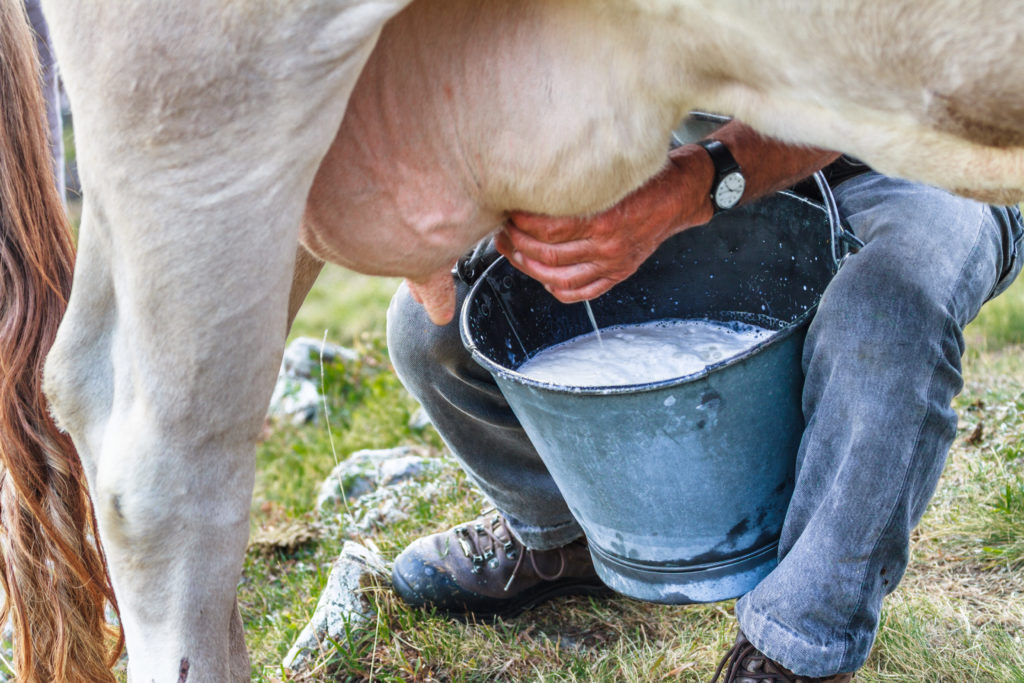What should you consider when it comes to your dairy intake?
These days, it seems there’s lot of confusion around dairy. On the one hand, the Office of Disease Prevention and Health Promotion (ODPHP) recommends consuming dairy as part of a healthy eating pattern. On the other hand, independent health experts and those who support Paleo and vegan diets strongly advocate avoiding dairy for better health.
So what should you do?
Firstly, it’s important to realize that there are different kinds of dairy. Raw milk and pasteurized milk are worlds apart. Skim milk from the supermarket is stripped of nutrients, watered down, and highly processed. You can’t place it in the same group as raw, organic, grass-fed, full-fat milk and cultured milk products—which notable groups like the Weston Price Foundation recommend.
That gives you two options: consume regular pasteurized dairy, or consume raw, organic, grass-fed, full-fat dairy. But there’s also a third option: going dairy-free. Let’s compare the benefits and drawbacks of all three.
Pasteurized, Homogenized Dairy
Milk is normally pasteurized to prevent contamination from pathogens like E. coli and listeria. Even so, there’s no guarantee that pasteurization will prevent bacterial contamination altogether. In fact, most outbreaks of dairy-borne pathogens can usually be traced back to products that were contaminated after pasteurization. (See this study on cheese-related outbreaks.)
We must also consider the unfortunate side-effects of the pasteurization process. It not only reduces the vitamin content of milk, but it also kills the healthy bacteria (probiotics) that are vital to a healthy gut—and that you’ll find in raw milk.
We often hear that skim milk and low-fat dairy products like yogurt are good for our health. And in fact, the ODPHP recommends them. However, nonfat and low-fat dairy could actually be worse for our health. Why? Removing the fat from milk also removes many fat-soluble vitamins (particularly vitamins A, E, and F) that are critical to heart health. Removing the fat also removes the great flavor that fat imparts. To make up for this, manufacturers typically add chemical flavorings and sugar. Have a look at the ingredients listed on low-fat yogurt the next time you’re at the supermarket. See how many of them you recognize.
Finally, conventional milk is usually produced by factory-farmed dairy cows. From an ethical and environmental perspective, this is reason enough to avoid regular dairy. (You can easily find graphic videos that illustrate the terrible conditions these cows are kept in.) But it’s also important for health reasons to stay clear of dairy from factory-farmed cows. They’re raised in unsanitary and crowded conditions. To prevent disease, the cows are dosed with antibiotics. And to increase yield, the cow are given growth hormones. The antibiotics and hormones given to the cows end up in the milk they produce as well as the dairy products made from it. And, eventually, you’ll end up consuming these substances too.
Benefits of Raw, Organic, Grass-Fed, Full-Fat, Dairy
Raw dairy is an essential part of many traditional cuisines around the world. The most recognizable examples include raw milk cheeses from Europe: Italian Parmesan, Dutch Gouda, and French Camembert. The traditional manufacturing process has been refined over time, and now modern cheese-makers know how to use good bacteria to prevent harmful microbes from contaminating their product. It’s these good bacteria that give the cheeses a fuller flavor than their pasteurized counterparts.
Raw milk cheese is the most nutrient dense form of dairy. Packed with protein, magnesium, and probiotics, raw milk cheese offers a whole host of health benefits. However, though vitamins D and K are often attributed to milk and cheese, the presence of these vitamins totally depend on the quality of the animal’s diet. That means they may not be present in some milk and cheese at all, and if they are, it’s never in large amounts.
On the other hand, the probiotic bacteria in raw milk cheese can help heal digestive disorders, even in those with dairy sensitivities, as Monica Corrado explains in Cooking Techniques for the Gut and Psychology Syndrome, Part II: Culturing Dairy. Unlike dairy from grain-fed cows, which contributes to inflammation, grass-fed dairy helps your body fight inflammation. That’s why consuming raw milk can help clear up skin conditions like eczema.
But is raw milk safe? Raw milk products are subject to rigorous testing and strict regulations to ensure they’re safe for both adults and children. According to one study, children who consume raw dairy are less likely to develop asthma and allergies later in life. Another study on cheese production concludes that raw milk cheeses are no riskier than those made from pasteurized milk. (Safety was determined by factors other than pasteurization.)
Furthermore, when you buy raw dairy products from a local organic farm, you can ensure that it’s cruelty-free. Buying locally is also better for the environment: it reduces the amount of miles your food must travel to get to you. And according to a study carried out in Germany, organic farming has a lower environmental impact than conventional farming methods.
Dairy-Free
The most important thing to watch out for when switching to a dairy-free diet—especially if you don’t eat meat or eggs—is nutritional deficiencies. Vitamin B12, for example, is found only in animal products. And milk, whether raw or pasteurized, is not high in vitamin D. As mentioned earlier, the presence of vitamin D in milk depends solely on the cow’s diet. Most milk at the supermarket is artificially fortified with synthetic vitamins, especially vitamin D. So if you’re going dairy-free, you’ll need to get enough vitamin D the old fashioned way: from the sun.
You’ll also have to find another source of probiotics to ensure your gut stays healthy and your bowel movements stay regular. This doesn’t mean you’re doomed without dairy—you just need to include plenty of fermented foods (sauerkraut, pickles, kimchi, even tempeh) in your diet.
Milk substitutes are another pitfall to consider. The majority of these are highly processed and should be avoided. Soy milk, the most popular alternative, gets its flavor from gums, starches, fillers, and artificial sweeteners. It also contains two isoflavones (genistein and daidzein) that act like estrogen, making it unhealthy for everyone, including infants. The human body has a tough time digesting soy, leading to bloating and gas. When it comes to plant-based milks, by far the healthiest solution is to make your own out of almonds, cashews, or other nuts.
Although it’s possible to stay healthy on a dairy-free diet, it might be more trouble than it’s worth. Cutting out all dairy (pasteurized and raw) makes it harder rather than easier to avoid processed foods. Not only that, but it makes it more challenging to keep your diet as varied as possible. Most of us don’t need to give up dairy if we want to be healthy. We just have to switch the kind of dairy we consume. Veganism has gained superstar status in recent years, thanks to a crowd of celebrity supporters. So if you’re considering giving up all types of dairy—even the healthy ones—make sure it’s for the right reasons.
Final Thoughts
If you want to consume a healthy diet, make sure you eat mostly unprocessed, nutrient dense foods. By integrating raw dairy products into your diet, you’ll benefit from the valuable nutrients and avoid the harmful side-effects of regular pasteurized dairy and dairy substitutes.
To learn more about the history, politics, and science of raw milk, I recommend The Untold Story of Milk by Ron Schmid, ND. While you’re at it, check out RealMilk.com for safety information, current events, and where to find raw milk.
Photos from iStock/Kaszojad (main image), FedevPhoto (milking cow).



